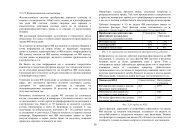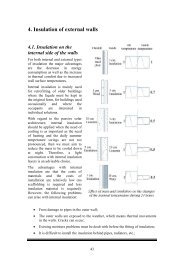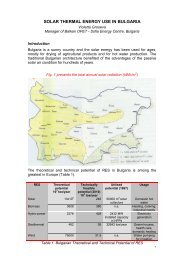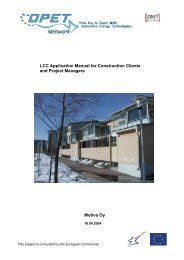Guidebook for Energy Efficiency in Municipalities
Guidebook for Energy Efficiency in Municipalities
Guidebook for Energy Efficiency in Municipalities
You also want an ePaper? Increase the reach of your titles
YUMPU automatically turns print PDFs into web optimized ePapers that Google loves.
Light<strong>in</strong>g overview<br />
T3<br />
Light<strong>in</strong>g accounts <strong>for</strong> about a third of all electricity used <strong>in</strong> municipal build<strong>in</strong>gs, while<br />
street light<strong>in</strong>g normally uses more energy than any other municipal activity. Light<strong>in</strong>g is<br />
also important to a municipality because illum<strong>in</strong>ation affects:<br />
the ability of staff and citizens to see accurately, affect<strong>in</strong>g their ability to read, work<br />
and move safely;<br />
the appearance, ambience and functionality of a build<strong>in</strong>g and its fitt<strong>in</strong>gs, affect<strong>in</strong>g the<br />
mood and morale.<br />
When look<strong>in</strong>g <strong>for</strong> ways to cut energy use, probably the first action most people th<strong>in</strong>k of is<br />
switch<strong>in</strong>g off lights. This is of course very effective, but there are many other ways to<br />
reduce light<strong>in</strong>g energy use, some of which are described here. Opportunities particularly<br />
relevant to offices and street light<strong>in</strong>g are presented <strong>in</strong> the correspond<strong>in</strong>g topics below.<br />
Opportunities <strong>for</strong> sav<strong>in</strong>gs<br />
Use of daylight<br />
Daylight is the most abundant and easily used <strong>for</strong>m of free, renewable energy (solar<br />
energy). A daylight sensor can control outside light<strong>in</strong>g and light<strong>in</strong>g <strong>in</strong> atria. Some sensors<br />
have an adjustable light-level sett<strong>in</strong>g, mak<strong>in</strong>g them suitable <strong>for</strong> areas which have access<br />
to natural light<strong>in</strong>g but which require a higher light<strong>in</strong>g level than the sett<strong>in</strong>g of standard<br />
sensors. Such areas could <strong>in</strong>clude glazed foyers, some depot build<strong>in</strong>gs, <strong>in</strong>door swimm<strong>in</strong>g<br />
pool halls, undercover park<strong>in</strong>g, or childcare centres.<br />
In some cases, modest changes to a build<strong>in</strong>g will permit better use of natural light<strong>in</strong>g—<strong>for</strong><br />
example, skylights <strong>in</strong> a depot workshop or garage. Pa<strong>in</strong>t<strong>in</strong>g <strong>in</strong>ternal surfaces with light<br />
colours and trimm<strong>in</strong>g vegetation back so w<strong>in</strong>dows have greater access to the sky can<br />
improve the effectiveness of day light<strong>in</strong>g. Pa<strong>in</strong>t<strong>in</strong>g walls outside w<strong>in</strong>dows with light<br />
colours to reflect more light <strong>in</strong>to the room can also make a remarkable difference to the<br />
amount of useful daylight.<br />
Us<strong>in</strong>g daylight <strong>in</strong>side a build<strong>in</strong>g will improve the quality of the light<strong>in</strong>g <strong>in</strong> municipal<br />
build<strong>in</strong>gs by improv<strong>in</strong>g colour render<strong>in</strong>g, elim<strong>in</strong>at<strong>in</strong>g flicker and giv<strong>in</strong>g people a l<strong>in</strong>k to the<br />
outside environment. However, too much daylight, especially direct sun, can create glare<br />
problems and excessive heat. For example, a square metre of clear roof glaz<strong>in</strong>g <strong>in</strong> direct<br />
sun delivers as much light as up to 40 standard 36-watt fluorescent lamps 1 . Good design<br />
of day-light<strong>in</strong>g systems is critical.<br />
Use the right amount of light<br />
People need more light to read than they do to walk down a corridor, but offices and other<br />
build<strong>in</strong>gs are often lit with the same light<strong>in</strong>g <strong>in</strong>tensity throughout. Over-light<strong>in</strong>g wastes<br />
energy and money without produc<strong>in</strong>g any benefit. There are national and <strong>in</strong>ternational<br />
standards that recommend appropriate light<strong>in</strong>g levels <strong>for</strong> various tasks, and the follow<strong>in</strong>g<br />
table provides a first orientation (but each time the national standards should be used.<br />
1 ‘Standard’ means a fluorescent lamp (tube) which is not a tri-phosphor lamp. Compared with a triphosphor<br />
lamp, a standard fluorescent lamp has a shorter life (i.e. 8,000 hours compared with 16,000-24,000<br />
hours), lower efficacy (lower light output <strong>for</strong> the same electrical power draw), poorer light colour, and<br />
quicker per<strong>for</strong>mance degradation (ag<strong>in</strong>g).






